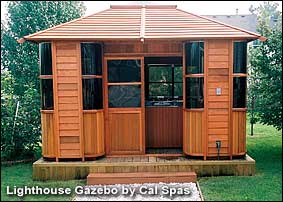
Gazebos
Gazebos run the gamut from the very elegant, fairy tale garden gazebo to a unique gathering place to four-post aluminum frame structures that most would call canopies.
Read Full Article
Building System, Architecture, House Style, more

Gazebos
Gazebos run the gamut from the very elegant, fairy tale garden gazebo to a unique gathering place to four-post aluminum frame structures that most would call canopies.
Read Full Article
Labels: Yardscape
Labels: Yardscape
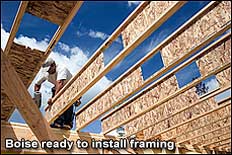
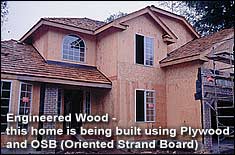
Engineered Wood
New building systems and high-tech products are changing the way builders construct new homes. An alternative construction method using engineered wood components is leading the way into tomorrow.
Read Full Article
Labels: Structure
 Leading the way in new building systems and high-tech products are engineered wood products. They offer high-performance, consistency, reliability and are an environmentally sound choice in new home construction.
Leading the way in new building systems and high-tech products are engineered wood products. They offer high-performance, consistency, reliability and are an environmentally sound choice in new home construction.Labels: Structure


Choosing Your Stairs
Beyond performing their purely practical functions as vertical passageways, most staircases serve as powerful design elements, presenting strong vertical line, rhythm and pattern, and graceful forms. A stairway is an opportunity for you to be expressive.
Read Full Article
Labels: Stairs
 Staircases are not only for practical functions and vertical passageways. Staircases serve as powerful design elements, presenting strong vertical lines, rhythm and pattern, and graceful forms. Stairways can be difficult and expensive to build. Handcrafted hardwood varieties that are custom built can be very costly.
Staircases are not only for practical functions and vertical passageways. Staircases serve as powerful design elements, presenting strong vertical lines, rhythm and pattern, and graceful forms. Stairways can be difficult and expensive to build. Handcrafted hardwood varieties that are custom built can be very costly.Labels: Stairs
Glass and Acrylic Block
Glass and acrylic block is beautiful, strong, sound-deadening and allows natural light to enter while still giving privacy.
Read Full Article
Labels: Specialty Products
 A practical and unique way to enhance a home is to use glass and acrylic block. With lots of new products, colors, shapes, and custom configurations available, there are unlimited creative ideas. While looking great, they are also strong, sound-deadening, thermal insulated, good security and fire protection, and allow natural light to enter while still giving privacy.
A practical and unique way to enhance a home is to use glass and acrylic block. With lots of new products, colors, shapes, and custom configurations available, there are unlimited creative ideas. While looking great, they are also strong, sound-deadening, thermal insulated, good security and fire protection, and allow natural light to enter while still giving privacy.Labels: Specialty Products
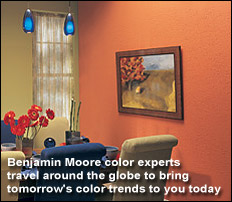
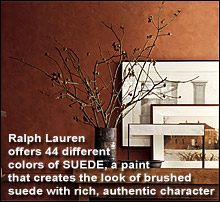
Wall Coverings
They are the background of every room; they set the tone for your house; they are the first way that you begin creating your environment-they are your walls. With recent technological advances, fashioning a new mood has never been easier-or more fun. From paint to wallpaper to (yes) leather, today's wall coverings are only limited by your imagination.
Read Full Article
Labels: Lighting and Fixtures
 Every room of your home has a background that sets the tone of your house. These backgrounds are your walls. Today's wall covering options are limitless: from paint to wallpaper to leather. Changing the mood of your room has become easy and fun.
Every room of your home has a background that sets the tone of your house. These backgrounds are your walls. Today's wall covering options are limitless: from paint to wallpaper to leather. Changing the mood of your room has become easy and fun.Labels: Paint and Decorating
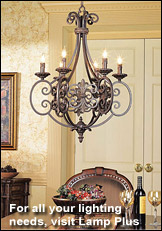
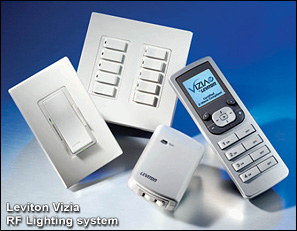
Ceiling Fans
Ceiling fans are an important part of creating the perfect home decor. During the last decade ceiling fans have become much more technologically advanced and aesthetically pleasing. They provide cooling during the summer months and warming during the winter months, which saves you a lot of money on your yearly energy bills.
Read Full Article
Home Lighting
Home lighting is probably the most important element in home interior decorating, because it is instrumental in setting the mood of any room. It can affect performance, mood, morale, safety and security. When deciding what lighting to use in your new home it's important to consider how each room will be used, what fixtures are appropriate, energy efficiency and cost.
Read Full Article
Labels: Lighting and Fixtures
 There's no single way to live, decorate or even light your home. Just as one person prefers the hustle and bustle of city life, another seeks the quiet solitude of the country. While one feels comfortable with a new urban look, another is coziest with cottage. And where one might pair two mini-chandeliers to accentuate a dining room, another might use a large chandelier with twin sconces. Yet living, decorating and lighting your home have one thing in common. All three revolve around style: lifestyle, home-style and personal style, making all three important elements when properly lighting each room.
There's no single way to live, decorate or even light your home. Just as one person prefers the hustle and bustle of city life, another seeks the quiet solitude of the country. While one feels comfortable with a new urban look, another is coziest with cottage. And where one might pair two mini-chandeliers to accentuate a dining room, another might use a large chandelier with twin sconces. Yet living, decorating and lighting your home have one thing in common. All three revolve around style: lifestyle, home-style and personal style, making all three important elements when properly lighting each room.Labels: Lighting and Fixtures
Labels: Lighting and Fixtures
 Ceiling fans have become much more technologically advanced and appealing. They are often a large part of a home's decor. They help to cool the home in the summer and warm it in the winter. Ceiling fans can reduce your energy cost by 40% in the summer and 10% in the winter. Fans are used throughout the home in main rooms, kitchens, bathrooms, verandas, patios, and etc. They add to the rooms appeal and lower dampness.
Ceiling fans have become much more technologically advanced and appealing. They are often a large part of a home's decor. They help to cool the home in the summer and warm it in the winter. Ceiling fans can reduce your energy cost by 40% in the summer and 10% in the winter. Fans are used throughout the home in main rooms, kitchens, bathrooms, verandas, patios, and etc. They add to the rooms appeal and lower dampness.Labels: Lighting and Fixtures
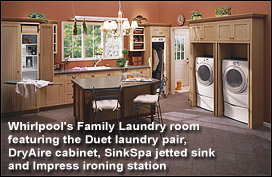
Laundry Room Ideas
Your laundry room may not be the most favorite room in your house - since it means washing, drying and folding - but with a little planning you can turn this room into an efficient workplace. Generally, architects would place the laundry in a closet or hallway off the kitchen or in the garage, but today they're finding more practical places to put the laundry like a seldom used bathroom or on the second floor next to the bedrooms (closest to the dirty clothes).
Read Full Article
Washing Machines
Moving into a new home often means new purchases for appliances and furniture. If you're in need of a new washing machine, you'll be amazed at all of the options now available even from just a few years ago.
Read Full Article
Labels: Laundry Ideas
 When you are finished building your new home, you may also need new appliances when you move in. If you are purchasing a new washing machine, there are many new options available to choose from. They have become more water, energy, and time efficient with more washing options.
When you are finished building your new home, you may also need new appliances when you move in. If you are purchasing a new washing machine, there are many new options available to choose from. They have become more water, energy, and time efficient with more washing options.Labels: Laundry Ideas
 Did you know that the average household does seven to eight loads of laundry every week? The laundry room used to typically be a spare closet in the hallway near the kitchen or in the garage.
Did you know that the average household does seven to eight loads of laundry every week? The laundry room used to typically be a spare closet in the hallway near the kitchen or in the garage.Labels: Laundry Ideas
 Dryers contribute to the life and appearance of your clothing. For this reason it is important to choose a quality dryer to suit your wardrobe. Dryers are available in gas or electric, but all spin the clothes while blowing hot air on them. Gas dryers are usually a little higher priced alternative, but tend to be more cost efficient in the long run compared to electric. Know that just because a dryer advertises 'extra large', this doesn't necessarily mean that the capacity is large. You should choose a dryer that is compatible with your washer size so that you can dry your clothes as they are washed, not let wet clothes stack up while the dryer is running. The general rule of thumb is to have about twice as much capacity in the dryer than in the washer. So if you buy a 3.3 or 3.5 cu. ft. washer, you will need a 7 cu. ft. dryer.
Dryers contribute to the life and appearance of your clothing. For this reason it is important to choose a quality dryer to suit your wardrobe. Dryers are available in gas or electric, but all spin the clothes while blowing hot air on them. Gas dryers are usually a little higher priced alternative, but tend to be more cost efficient in the long run compared to electric. Know that just because a dryer advertises 'extra large', this doesn't necessarily mean that the capacity is large. You should choose a dryer that is compatible with your washer size so that you can dry your clothes as they are washed, not let wet clothes stack up while the dryer is running. The general rule of thumb is to have about twice as much capacity in the dryer than in the washer. So if you buy a 3.3 or 3.5 cu. ft. washer, you will need a 7 cu. ft. dryer.Labels: Laundry Ideas
Appliances: How To Decide
You don't want to begin your journey looking for kitchen appliances unprepared. Because an appliance showroom is packed with products, it can be an overwhelming experience if you don't know exactly what you want.
Read Full Article
Kitchen Sinks and Faucets
It wasn't long ago when homeowners had two choices when it came to selecting a new kitchen sink: cast iron or stainless steel. There were fewer choices of colors or shapes and no options for customized sink accessories. Today, homeowners have a multitude of sink choices to help personalize their kitchen.
Read Full Article
Labels: Kitchens Ideas
 Don't go overboard on all the fancy new features available on the new refrigerators. The sole purpose of a refrigerator is to keep your food fresh, beverages cold, and icebox chilled. What you should be looking for when you are looking at refrigerators is the amount of free space, accessibility, and practical special features. The cubic footage is the first important thing. As a rule of thumb start with the smallest size of ten cubic feet for two people and add one cubic foot for each additional family member. As a general rule, when you are looking for a refrigerator, you will find that most appliance dealers carry about five different sizes that vary from 15 cu. ft. to 26 cu. ft. So you will need to choose the size they carry that is closest to what you need. They may even be able to order the size you want or something close to it. If you like to keep your refrigerator well stocked, you may as well choose a larger refrigerator to start with.
Don't go overboard on all the fancy new features available on the new refrigerators. The sole purpose of a refrigerator is to keep your food fresh, beverages cold, and icebox chilled. What you should be looking for when you are looking at refrigerators is the amount of free space, accessibility, and practical special features. The cubic footage is the first important thing. As a rule of thumb start with the smallest size of ten cubic feet for two people and add one cubic foot for each additional family member. As a general rule, when you are looking for a refrigerator, you will find that most appliance dealers carry about five different sizes that vary from 15 cu. ft. to 26 cu. ft. So you will need to choose the size they carry that is closest to what you need. They may even be able to order the size you want or something close to it. If you like to keep your refrigerator well stocked, you may as well choose a larger refrigerator to start with.Labels: Kitchens Ideas
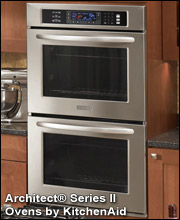 Conventional, convection, microwave, and combination are the choices you have for your new oven. What are they and what are the differences?
Conventional, convection, microwave, and combination are the choices you have for your new oven. What are they and what are the differences?Labels: Kitchens Ideas
 Merillat offers ways to make the most out of a kitchen Island
Merillat offers ways to make the most out of a kitchen IslandLabels: Kitchens Ideas
 In today's world there are many styles and colors to choose from when purchasing a new sink for your home. The only available choices in the past were cast iron and stainless steel in very few sizes and colors. You could not order a customized sink and you had to design around what was available. Now you can select a sink to fit your design as well as faucets to compliment that style. Here is a guide to some of the choices that are out there for consideration.
In today's world there are many styles and colors to choose from when purchasing a new sink for your home. The only available choices in the past were cast iron and stainless steel in very few sizes and colors. You could not order a customized sink and you had to design around what was available. Now you can select a sink to fit your design as well as faucets to compliment that style. Here is a guide to some of the choices that are out there for consideration.Labels: Kitchens Ideas
 Two decades ago, choosing a countertop was not at all difficult. You chose from less than twenty variations on color of plastic laminate. It was simple. Today the interest and desire of consumers to have a more practical style of countertop has revolutionized the market. Countertops are no longer merely a work surface, but a key element in the design and luxury of your home.
Two decades ago, choosing a countertop was not at all difficult. You chose from less than twenty variations on color of plastic laminate. It was simple. Today the interest and desire of consumers to have a more practical style of countertop has revolutionized the market. Countertops are no longer merely a work surface, but a key element in the design and luxury of your home.Labels: Kitchens Ideas